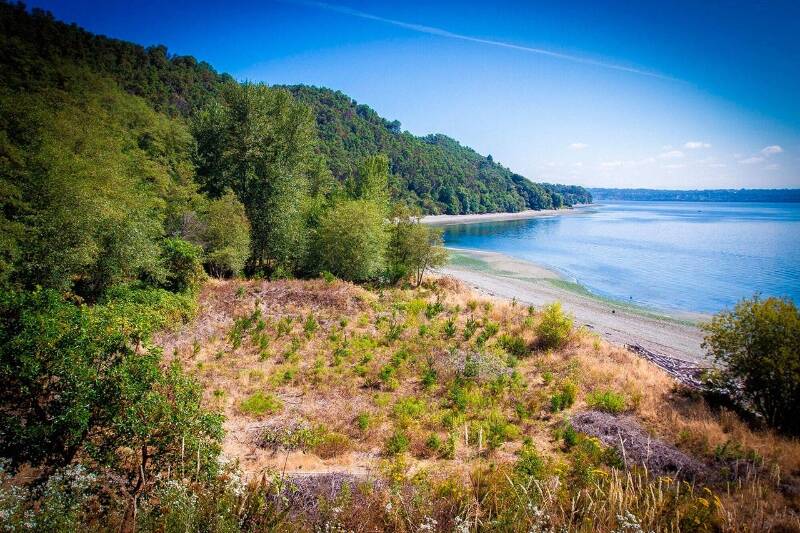The end is in sight for King County’s cleanup at the Maury Island Natural Area, where for years toxic chemicals from the historic Tacoma Smelter plume contaminated the soil.
The state Department of Ecology is seeking public review of a proposed amendment to the legal agreement, which would update a timeline for the rest of the work at the site — including a final completion date of 2029.
The amendment comes after years of cleanup already finished at the Natural Area. As of December, the county has finished the first two phases of the cleanup plan, which included capping trails and cleaning up contamination from a former skeet shooting range.
The proposed amendment would also direct King County to enact an “environmental covenant” restricting land use on the site, primarily for safety reasons, and the amendment would update legal language in the agreement.
A brief history
King County purchased the Maury Island Natural Area — which the state calls the Maury Island Open Space Cleanup Site — in 2010, after a long fight with Glacier Northwest, which had intended to expand the sand and gravel mining operation it operated there. Local environmentalists and citizen’s organizations led the decade-plus-long successful fight to block expansion of the gravel mine, which had sat dormant since the 1970s.
While the mine looms large in the environmental history of the park, it is not actually considered to be a significant source of contamination for this cleanup project, according to county and state Department of Ecology staff.
“It’s all the way down the priority list” when it comes to culprits of contamination at the site, said Ryan Gardiner, the Ecology site manager for the project.
More specifically, Gardiner wrote in an email: “The Remedial Investigation (RI) discusses the impact of the mining operation on the park, including things such as pilings, foundations, road construction, turbidity impacts to the Sound, and invasive species. However, the remedy is focused on the constituents that exceed Model Toxics Control Act (MTCA) cleanup levels. The RI suggests that arsenic concentrations are lower in former mining areas because the mining operation removed most soils impacted by the [ASARCO] smelter plume.”
Now the 266-acre site is preserved as park space, and islanders use it for a variety of non-motorized recreational activities, including hiking, mountain biking and horseback riding. With more than a mile of undeveloped shoreline — the longest undeveloped stretch of Puget Sound shoreline in King County — the park supports endangered species such as chinook salmon and orcas and is home to madrone forests.
So how did the site become contaminated? It was downwind of the former Tacoma ASARCO copper smelter, which for years blew fallout like arsenic and lead over a 1,000 square mile area. The soil on Maury Island was “among those most significantly impacted” from the plume, according to the cleanup action plan. The smelter was decommissioned in 1986.
A former skeet shooting range also contributed to contaminants in the soil.
The state Department of Ecology examined the site and found contaminants far in excess of determined cleanup levels. The contaminants are lead, which is linked to learning and behavior problems in children; cadmium, which increases the risk of respiratory, cardiovascular and renal problems, and arsenic and polycyclic aromatic hydrocarbons (PAHs), both of which increase cancer risk.
The contaminated areas are those in the upland and bluff areas and in the former skeet range, the Ecology report states.
In buying the Maury Island site more than a decade ago, King County agreed to take on all responsibility for remediating hazardous substances there, according to the county.
The cleanup plan
An agreed order for the site, signed in 2013, tasked the county with drafting a cleanup action plan, and Ecology issued its final cleanup action plan in 2019. The 10-year plan requires King County to:
- Revegetate several areas within the site.
- Cap maintenance roads and the majority of trails with a minimum of 3 to 4 inches of compacted gravel and a 3-inch thick layer of mineral soil (or equivalent), isolating contaminated soil so it cannot harm the environment.
- Decommission some trails and redundant trail spurs.
- Complete limited wetland remediation near the gravel parking lot.
The county finished capping trails in the area in 2019. By 2020, it finished cleaning up the skeet range.
The proposed amendments now on the table aren’t very complicated. They confirm the final phases of the county’s 2019 cleanup action plan: Through 2029, the county is scheduled to continue clearing and planting acres of the area, with complete wetland remediation finished by December 2026.
“One of the key aspects of the amendment … is not that any of the cleanup changed, it’s just when it will be (finished), and that’s captured in the document,” said Ecology senior outreach planner Ian Fawley. “There were no changes to any of the actual clean up.”
The remaining cost to finish the cleanup is about $4.5 million, with a completion date expected in 2029. Monitoring and maintenance of the cleanup site would continue “in perpetuity,” according to the amendment.
The amendments also pave the way for a new environmental covenant covering land use restrictions — the exact language of which has not yet been drafted. In essence, the covenant would ensure that cleanup and remediation work remains and is maintained, Fawley said — and that Ecology must be notified in case there are any changes in plans for the land.
“We want to make sure that’s safe for the people recreating there, and the workers too,” he said.
Get involved
A fact sheet with information on the proposed amendments should arrive in island mailboxes by Feb. 26. Comments on the proposal must be submitted between Feb. 26 and March 26.



